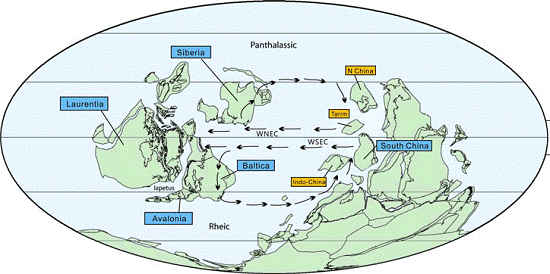Following the extinctions caused by the end-Ordovician (Hirnantian) glaciations, the world gradually returned to warmer climates, together with rising eustatic sea levels. As a result of those changes, benthic faunas steadily increased in diversity through the Early Silurian (Llandovery Series),and of those faunas, brachiopods are the most abundant.
Recently, Professor RONG Jiayu from Nanjing Institute of Geology and Palaeontology, Chinese Academy of Sciences and Professor Robin Cocks from Natural History Museum, London, UK reviewed Silurian brachiopods of Middle Llandovery (Aeronian) ages. More than 200 genera are identified, compared with 109 in the preceding Early Llandovery (Rhuddanian), indicating a recovery-radiation interval after the end-Ordovician mass extinction. The chief regions in which they are found are the continents of South China, Avalonia-Baltica, Laurentia and Siberia, which were all at tropical latitudes with the exception of Avalonia. In addition, the very large super terrane of Gondwana, although with patchy brachiopod distribution, included temperate faunas, as well as subtropical faunas (in Iran and Afghanistan). Aeronian brachiopods greatly increased in diversity, with dominance of four major groups: orthides and strophomenides(which had flourished previously in the Rhuddanian), pentamerides and atrypides (which became dominant in the Aeronian), and many newly evolved taxa, and occupied deeper water and wider ecological niches (level bottom and reef) than those in the Rhuddanian. Each of the continents has some endemic genera, but there is agreater proportion of them in South China, where some groups (such as the pentamerides and atrypides) are more diverse and others, such as the orthides, are much less common than elsewhere. Affinity indices (AI) show that two megaunits can be recognized: South China and Avalonia-Baltica-Laurentia (ABL); Siberia seems to have been loosely connected with ABL and even more loosely to South China presumably because of its geographical separation in the Northern Hemisphere. The separation of South China from the other megaunits is further supported by cluster analysis.
The research results have been published in Lethaia ( RONG Jiayu, Cocks L.R.M. 2014: Global diversity and endemism in Early Silurian (Aeronian) brachiopods. Lethaia, Vol. 47, pp. 77–106.)

Global palaeogeography in the Early Silurian at about 440 Ma, with the names of thecontinents discussed. WNEC andWSEC are ‘Western North Equatorial Currents’ and ‘Western South Equatorial Currents’.
